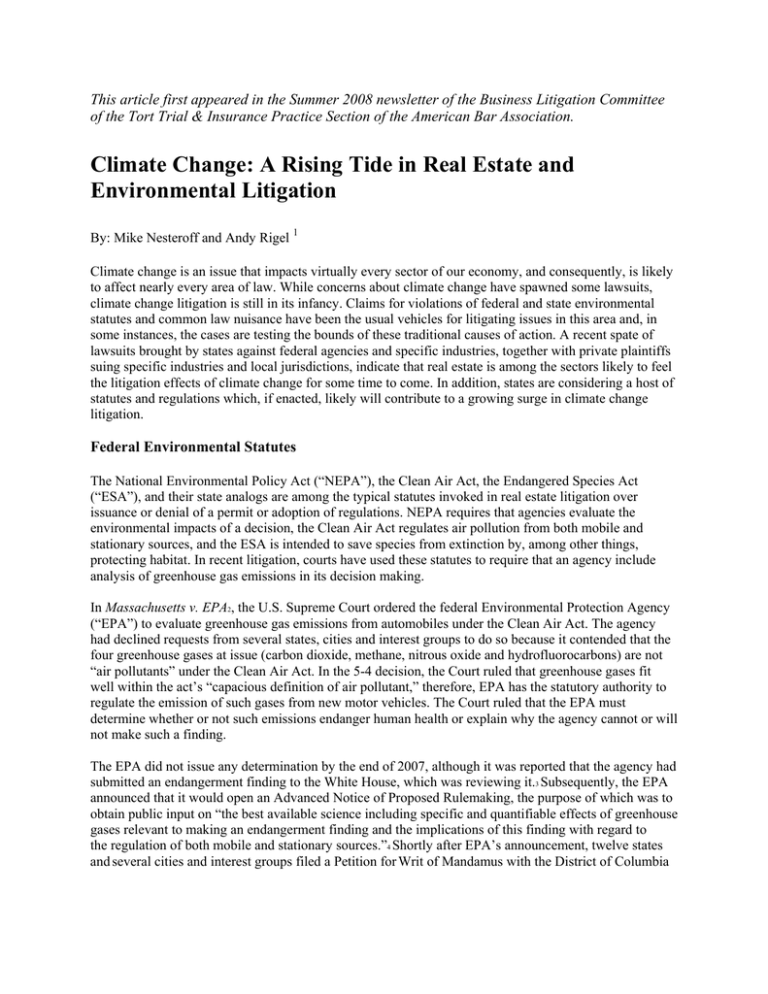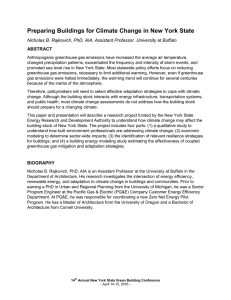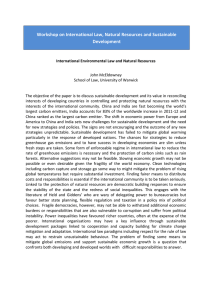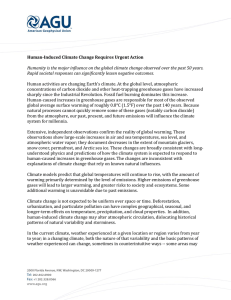This article first appeared in the Summer 2008 newsletter of... of the Tort Trial & Insurance Practice Section of the...
advertisement

This article first appeared in the Summer 2008 newsletter of the Business Litigation Committee of the Tort Trial & Insurance Practice Section of the American Bar Association. Climate Change: A Rising Tide in Real Estate and Environmental Litigation By: Mike Nesteroff and Andy Rigel 1 Climate change is an issue that impacts virtually every sector of our economy, and consequently, is likely to affect nearly every area of law. While concerns about climate change have spawned some lawsuits, climate change litigation is still in its infancy. Claims for violations of federal and state environmental statutes and common law nuisance have been the usual vehicles for litigating issues in this area and, in some instances, the cases are testing the bounds of these traditional causes of action. A recent spate of lawsuits brought by states against federal agencies and specific industries, together with private plaintiffs suing specific industries and local jurisdictions, indicate that real estate is among the sectors likely to feel the litigation effects of climate change for some time to come. In addition, states are considering a host of statutes and regulations which, if enacted, likely will contribute to a growing surge in climate change litigation. Federal Environmental Statutes The National Environmental Policy Act (“NEPA”), the Clean Air Act, the Endangered Species Act (“ESA”), and their state analogs are among the typical statutes invoked in real estate litigation over issuance or denial of a permit or adoption of regulations. NEPA requires that agencies evaluate the environmental impacts of a decision, the Clean Air Act regulates air pollution from both mobile and stationary sources, and the ESA is intended to save species from extinction by, among other things, protecting habitat. In recent litigation, courts have used these statutes to require that an agency include analysis of greenhouse gas emissions in its decision making. In Massachusetts v. EPA2, the U.S. Supreme Court ordered the federal Environmental Protection Agency (“EPA”) to evaluate greenhouse gas emissions from automobiles under the Clean Air Act. The agency had declined requests from several states, cities and interest groups to do so because it contended that the four greenhouse gases at issue (carbon dioxide, methane, nitrous oxide and hydrofluorocarbons) are not “air pollutants” under the Clean Air Act. In the 5-4 decision, the Court ruled that greenhouse gases fit well within the act’s “capacious definition of air pollutant,” therefore, EPA has the statutory authority to regulate the emission of such gases from new motor vehicles. The Court ruled that the EPA must determine whether or not such emissions endanger human health or explain why the agency cannot or will not make such a finding. The EPA did not issue any determination by the end of 2007, although it was reported that the agency had submitted an endangerment finding to the White House, which was reviewing it.3 Subsequently, the EPA announced that it would open an Advanced Notice of Proposed Rulemaking, the purpose of which was to obtain public input on “the best available science including specific and quantifiable effects of greenhouse gases relevant to making an endangerment finding and the implications of this finding with regard to the regulation of both mobile and stationary sources.”4 Shortly after EPA’s announcement, twelve states and several cities and interest groups filed a Petition for Writ of Mandamus with the District of Columbia Circuit Court of Appeals to require the agency “issue within 60 days its determination on whether the air pollution to which greenhouse gas emissions from motor vehicles ‘may reasonably be anticipated to endanger public health or welfare.’”5 Meanwhile, litigation in the lower courts is pushing other state and federal agencies to evaluate climate change under the federal ESA. Two recent decisions from the Eastern District of California held that climate change impacts must be considered in ESA biological opinions. Natural Resources Defense Council v. Kempthorne6 involved a two- to three-inch fish called the Delta smelt, while Pacific Coast Federation of Fishermen’s Associations v. Gutierrez7 concerned stocks of Chinook salmon and steelhead, all of which were affected by the operation of the Central Valley and State Water Projects. Those projects use an extensive system of dams, tunnels, canals and reservoirs to store and transfer water throughout California. In the preparation of operating plans for the next 25 years, ESA required the agencies operating the projects to consult with the Fish and Wildlife Service on smelt and National Marine Fisheries Service on salmon. The consulted agencies were to prepare biological opinions, using the best scientific and commercial data available, to evaluate the effects of the proposed actions on the species’ survival and any potential alterations of critical habitat. During the preparation of the biological opinions, interest groups submitted several studies to the agencies about the potential effects of climate change on water supply reliability. In the smelt case, the Fish and Wildlife Service apparently recognized that the issue of climate change warranted further discussion. Nevertheless, neither opinion considered climate change impacts. In the smelt opinion, the agencies felt that the evidence was inconclusive and that they had adequately accounted for climate change through the use of a proxy measurement of changes in the location of optimum salinity in the smelt habitat. The biological opinions concluded that the operation of the diversion projects over the next 25 years either would not jeopardize the continued existence of the fish, or the impacts could be avoided or minimized through a program of conservation and adaptive management. Various public interest groups challenged the opinions on a number of grounds, including the assumption that the hydrology of the affected rivers and delta would follow historical patterns for the next two decades. District Judge Oliver W. Wanger held that the agencies improperly failed to consider global climate change evidence in the biological opinion on smelt. The court conceded that at least one of the climate change studies submitted by the interest groups was inconclusive, but it said that there were a number ofother studies brought to the agencies’ attention that predict anticipated climate change will adversely affect future water availability in the western United States. More importantly, the court said: “At the very least, these studies suggest that climate change will be an ‘important aspect of the problem’ meriting analysis in the [biological opinion].”8 Because the agencies did not meaningfully discuss the climate change issue, the court held it was “impossible to determine whether the information was rationally discounted because of its inconclusive nature or arbitrarily ignored.”9 In the salmon case, decided nearly a year after the smelt case, the agency, prompted in no small part by the court’s ruling on the smelt biological opinion, admitted that it should have included an explanation of its conclusions on the effects of global climate change and committed to address the issue in its ongoing, reinstated consultation.10 The global warming issue constituted only a small portion of the two lengthy fish decisions and, as district court level rulings, neither one is binding precedent in other jurisdictions. While the two cases could represent the leading edge of a trend towards requiring that ESA assessments include analysis of the impacts of climate change, Dirk Kempthorne, the Secretary of the Interior, pointedly stated in his announcement of the May 2008 listing of the polar bear as a threatened species that the ESA listing should not “open the door to use of the ESA to regulate greenhouse gas emissions from automobiles, 2 power plants and other sources. That would be a wholly inappropriate use of the ESA law. The ESA is not the right tool to set U.S. climate policy.”11 The same day, the U.S. Fish andWildlife Service issued a memorandum to the agency’s regional directors advising that greenhouse gas emissions in and of themselves will not trigger an ESA consultation for other species unless it is established that the emissions from the proposed action cause an indirect effect to a listed species or critical habitat. The memorandum states, “The best scientific data available today do not allow us to draw a causal connection between [greenhouse gas] emissions from a given facility and effects to listed species or their habitats, nor are there sufficient data to establish that such impacts are reasonably certain to occur.” For now, the government’s position casts considerable doubt on the consideration of climate change impacts in ESA decisions, but that position is likely to be the subject of court challenges and possible legislative action, and may be revoked next year with a new administration in Washington, D.C. State Environmental Statutes California, Massachusetts and several counties and cities in other states are adopting regulations that require government agencies making land use decisions take into account greenhouse gas emissions. Because the statutory and regulatory landscape is evolving, many of the state court cases filed before the statutes and regulations took effect have not required that local jurisdictions and developers consider climate change when assessing specific projects. That, however, is likely to change in due course. In State of California v. County of San Bernardino,12 the state and public interest groups sued San Bernardino County, the largest county in the U.S. and, at the time, the fastest growing in California, because it did not evaluate the increase in greenhouse gas emissions or efforts to mitigate those increases when it revised its growth plan through 2030. The lawsuits alleged that the California Environmental Quality Act (“CEQA”), the state equivalent to NEPA, required an environmental impact report that specifically analyzed greenhouse gas emissions, climate change and diesel engine exhaust. In August 2007 the parties settled the case, with the county agreeing to: (1) amend its general plan to add a policy describing the county’s goal of reducing greenhouse gas emissions reasonably attributable to discretionary land use decisions and internal government operations; (2) adopt a greenhouse gas reduction plan, which would include an inventory of existing sources in the county, a baseline inventory of emissions, a projected inventory of new greenhouse gases reasonably expected to be emitted by 2020 and a target for reducing those emissions; (3) prepare an environmental review of the greenhouse gas reduction plan; and (4) adopt feasible measures to control diesel engine exhaust in the county and prepare an environmental impact review of those measures. The San Bernardino case may have been the first, but it will by no means be the last, to use a state environmental policy statute to force a local jurisdiction to consider climate change impacts in its planning. This likely will filter down into permitting decisions for individual development projects. So far, however, in California the project-level lawsuits that have reached decision in the trial courts reject any requirement for including climate change under CEQA. For example, in January 2008, in Highland Springs Conference and Training Center v. City of Banning,13 a California superior court judge granted petitioners’ mandate that objected to a 1,500-home project on a number of grounds, but specifically rejected petitioners’ challenge to the city’s failure to analyze greenhouse gas emissions. In its decision, the court said the city was not required to consider global warming at the time it approved the project at issue. Other courts have ruled similarly,14 although as California adopts legislation and regulations to incorporate the climate change analysis into CEQA, the challenges are likely to shift to the substance of the analysis.15 San Bernardino also has had a cautionary effect elsewhere. In Washington state, it was the prospect of 3 “policy by litigation” that prompted the Washington Department of Ecology to issue a letter to more than a thousand state agencies and local jurisdictions to convene a working group to prepare specific recommendations and guidance for incorporating analysis of climate change and greenhouse gas emissions into Washington’s State Environmental Policy Act.16 Common Law Traditional tort claims, primarily nuisance, also are being used to litigate climate change issues. Two states, Connecticut and California, brought public nuisance lawsuits against industries seeking, in one, injunctive relief, and damages in the other. The district courts in both cases dismissed the claims on the grounds that the lawsuits presented non-justiciable political questions. In Connecticut v. American Electric Power Co, Inc.,17 eight states, the City of New York and several public interest groups brought public nuisance claims against several power companies alleging that the 650 million tons of carbon dioxide emitted annually by the defendants are a cause of global warming and should be abated. The court dismissed the claims because “the scope and nature of the relief Plaintiffs seek reveals the transcendently legislative nature of this litigation.”18 The court held that the relief sought would require it to determine the appropriate level to cap carbon dioxide emissions of the defendants, determine the appropriate percentage reduction to impose, create a schedule to implement the reductions, determine and balance the implications of such relief on negotiations with other countries concerning global climate change, assess and measure available alternative energy resources, and determine and balance the implications of such relief on U.S. energy sufficiency and national security – all without an initial policy determination being made by the elected branches.19 A similar fate befell California’s lawsuit against five automobile manufacturers in People v. General Motors Corp.,20 in which the state sought damages for creating and contributing to global warming. Defendants sought dismissal of the case and the court, following the lead of Connecticut v. AEP, granted the motion on the grounds that the complaint raised non-justiciable political questions going beyond the limits of the court’s jurisdiction. “The Court is left to make an initial decision as to what is unreasonable in the context of carbon dioxide emissions. Such an exercise would require the Court to create a quotient or standard in order to quantify any potential damages that flow from Defendants’ alleged act of contributing 30 percent of California’s carbon dioxide emissions.”21 A class action nuisance action in the Southern District of Mississippi by individual property owners against several coal companies in Comer v. Murphy Oil, U.S.A.,22 was no more successful than the two cases brought by the states. The plaintiffs in Comer alleged that the defendants’ emissions of greenhouse gases caused the increased frequency and intensity of storms, including Hurricane Katrina. The defendants sought dismissal on the same political question grounds relied on in the power generator and auto industry cases and the court granted the motions. All three cases are now on appeal to their respective circuits. Perhaps mindful of the fate of those cases, a fourth lawsuit is taking a slightly different tack and using an approach that was successful in litigation against the tobacco industry. In Native Village of Kivalina v. ExxonMobil Corporation,23 the governing bodies of an Inupiat village located on the edge of a barrier reef along the Chukchi Sea in northwest Alaska have sued 24 coal, oil and power companies claiming that the defendants’ greenhouse gas emissions contributed to global warming and are responsible for jeopardizing the village’s continued existence. The complaint alleges that the emissions have caused a loss of sea ice, making the village of 400 people more vulnerable to waves, storm surges and erosion. The U.S. Army 4 Corps of Engineers estimated that Kivalina soon would be uninhabitable and that it would cost several hundred million dollars to relocate the village inland. The lawsuit asserts claims for public nuisance under federal and state law, private nuisance under state law and civil conspiracy. The conspiracy claim is the new twist and replicates a tactic used in the tobacco litigation, where plaintiffs argued that the tobacco companies had conspired to deceive the public about the health risks of smoking.24 In the Kivalina case, the complaint alleges that the power, coal and oil companies conducted a campaign that, initially, attempted to show that global warming was not occurring and, later, “that global warming is good for the planet and its inhabitants or that even if there may be ill-effects, there is not enough scientific certainty to warrant action.”25 The complaint further alleges that defendants funded and used front groups and global warming skeptics who published their “marginal views expressing doubts about numerous aspects of climate change science” in popular news media, but not peer-reviewed journals.26 It is unclear whether the Kivalina lawsuit can survive motions to dismiss or overcome the significant legal and factual hurdles it faces. Regardless of its ultimate fate, the Kivalina case is an indication that climate change litigation is here to stay and that the boundaries of the common law will be tested and stretched in new ways. Forthcoming Statutes And Regulations The law of climate change is operating in a fairly limited universe of statutes and common law, but that universe is likely to expand and will do so rapidly in the coming years. Approximately 30 states have developed, or are developing, climate action plans that call for a wide range of new statutory and regulatory authority to reduce greenhouse gas emissions. These plans propose a number of strategies because, as one state global warming task force put it so succinctly, “There is no ‘silver bullet’ solution to climate change. Instead, the Task Force will propose a ‘silver buckshot’ strategy that requires action across all sectors of the economy[.]”27 The “silver buckshot” strategies include a number of proposals that involve or affect real estate, and include upgrading building codes to reduce energy use, integrating land use and transportation decisions with greenhouse gas consequences (for example, considering transportation demand management and expanded transit service before building roads) and local planning and state policy changes to target investments in greenhouse gas-efficient locations (i.e., locating homes near places people regularly go). The strategies also include promoting transit-oriented development, mixed-use development, minimum densities and parking standards, increasing farm and forest land base, and increased forestation of underproducing lands. Because many of the proposed regulations are still in the gestational stage, there is time and opportunity for interested parties to help shape the outcomes. Once that window closes, however, the strategies and the accompanying regulations to implement them are going to impose new duties and obligations that could present challenges in order to avoid or reduce expenses, including litigation exposure. Conclusion While state and federal agencies and legislative bodies study, debate and otherwise evaluate how to effectively regulate climate change, environmental advocacy groups and those harmed by the documented effects of climate change are not waiting for answers. Climate change litigation is filling the void left by the regulatory vacuum. Due to the rapid advancement of our understanding of the science of climate over the past several years, and because the federal government has been slow to react in providing a national 5 policy in this area, the litigation in the courts to date is just the beginning and the real estate and development sector can count on being involved in a multitude of future cases. 1 Michael Nesteroff is a shareholder with Lane Powell PC in its Seattle, WA, office, focusing on environmental and real estate litigation and advice. Andy Rigel is an associate in the Lane Powell PC Seattle office. Both are members of the Firm’s environmental practice group. 2 549 U.S. —-, 127 S.Ct. 1438 (2007). 3 Janet Wilson and Richard Simon, EPA staff finds emissions threat, L.A. TIMES, Jan. 24, 2008, available at http://articles.latimes.com/2008/10/24/news/na-endanger24. 4 Janet Wilson, EPA chief weighs risks of greenhouse gases, L.A. TIMES, March 28, 2008, available at http://articles/latimes.com/2008/mar/28/nation/na-greenhouse28. 5 Petition for Writ of Mandamus to Compel Compliance with Mandate, Massachusetts v. EPA, No. 03-1361 (D.C. Cir., Apr. 2, 2008). 6 506 F.Supp.2d 322 (E.D. Cal. 2007). 7 2008 WL 1766996 (E.D. Cal. Apr. 16, 2008). 8 506 F.Supp.2d at 369. 9 Id. 10 2008 WL 1766996, at * 59. 11 U.S. Department of Interior, Office of the Secretary, News Release, May 14, 2008, available at www.fws.gov/news/NewsReleases/showNews.cfm?newld=ECB61DDI-0D741D7B-4A67E9B51FB1626B. 12 Civ. 07-00329 (San Bernardino Sup. Ct.) 13 Highland Springs Conference & Training Center v. City of Banning, No. 460950 (Riverside Co. Sup. Ct., 2006). 14 See American Canyon Community United for Responsible Growth v. City of American Canyon, No. 26-27462 (Napa County Sup. Ct., May 27, 2007) (legislative mandate for creation of regulations did not trigger review of greenhouse gas emissions in an addendum to environmental impact report); NRDC v. The Reclamation Board, No. 06-CS-01228 (Sacramento County Sup. Ct., April 27, 2007) (court denied CEQA challenge on climate grounds because petitioners failed to present information about specific effects on area of project). 15 See Center for Biological Diversity v. City of Desert Hot Springs, No. RIC464585 (Riverside Co. Sup. Ct., 2007). 16 Available at http://www.ecy.wa.gov/climatechange. 17 406 F.Supp.2d 265 (D. Conn. 2005). 18 Id. at 272. 19 Id. at 272-73. 20 2007 WL 2726871 (N.D. Cal. Sept. 17, 2007). 21 Id. at * 8.\ 22 Civil Action No. 1:05CV436 (S.D. Miss.) 23 No. 08-CV-1138 (N.D. Cal. Feb. 26, 2008). 24 See, e.g., Complaint for Damages and Injunctive and Declaratory Relief, U.S. v. Phillip Morris, Inc., (D.D.C. Sept. 22, 1999) (available at: http://www.usdoj.gov/ civil/cases/tobacco2/complain.pdf). 25 Id. at 47, n.22. 26 Id. 27 A Wisconsin Strategy for Reducing Global Warming, Interim Report to Gov. Jim Doyle, at 2 (Feb. 2008), available at www.dnr.wi/gov/enrironmentprotect/ gtfgw/documents/interim_report.pdf. 6







